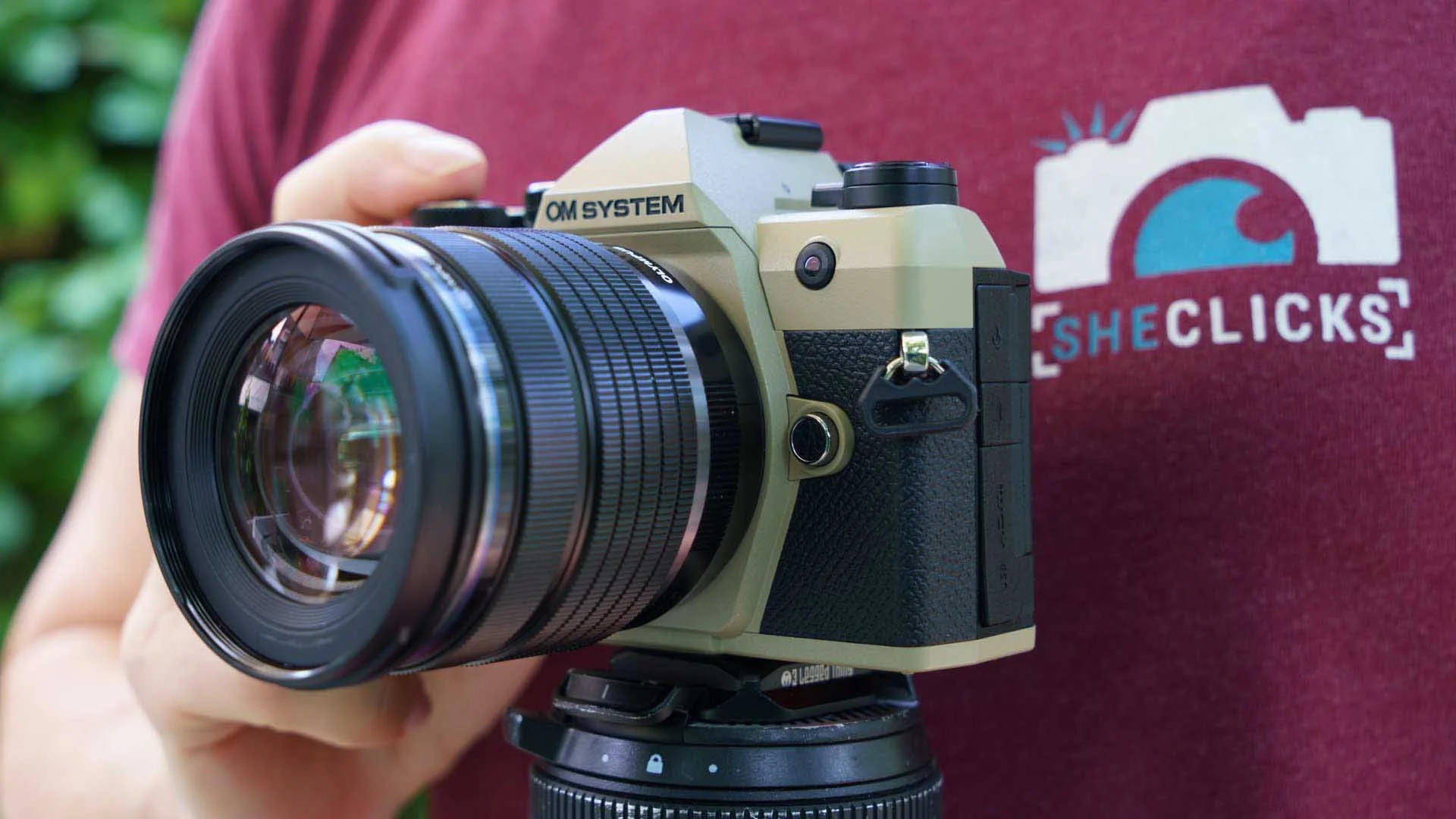OM System OM-5 Mark II Review
Summary Verdict
The OM System OM-5 Mark II refines a well-loved formula, introducing a few thoughtful upgrades while keeping the camera compact and easy to carry. It's clearly built with outdoor photography in mind and feels particularly suited to those who want to travel light without compromising on features. The addition of on-chip phase detection autofocusing, USB-C charging, a larger grip and enhanced video functionality make this a more rounded and user-friendly model, although the lack of AI-based subject detection is disappointing.. It’s a great fit for women photographers who enjoy a balance of creativity and simplicity.
Score: 4/5
For
Compact, weatherproof and an improved grip
CP (Computational Photography) button adds quick access to creative tools
USB-C charging and power via a power bank
Against
No subject detection autofocusing
No major technological upgrades
The OM System OM-5 II has a 3-inch vari-angle screen. that can be flipped and rotated to face forwards.
What is the OM System OM-5 Mark II?
The OM System OM-5 Mark II is a Micro Four Thirds mirrorless camera aimed at outdoor-loving photographers who value portability and performance. It follows on from the OM-5 with updates to enhance usability, especially for those upgrading from smartphones or experienced photographers looking for a more compact second body.
OM System OM-5 Mark II Price and Availability
The OM-5 Mark II is available body-only for £1,099 or in a kit with the M.Zuiko Digital ED 12–45mm F4.0 PRO lens or the M.Zuiko Digital ED 14-150mm F4.0-5.6 II for £1,499. It launches in mid-July 2025 in black, silver and a limited-edition Sand Beige available exclusively through Wex Photo Video in the UK.
The OM System OM-5 Mark II has a Four Thirds type sensor and the Micro Four Thirds lens mount.
OM System OM-5 II Specifications
Camera type: Mirrorless Micro Four Thirds
Announced: 17th June 2025
Sensor: 20.4MP Four Thirds type Live MOS
Processor: TruePic IX image processor
Stabilisation: 5-Axis in-body stabilisation giving up to 6.5EV compensation (7.5EV with compatible Sync IS lens)
Viewfinder: 2.36-million-dot OLED electronic viewfinder
Screen: 3-inch 1,040,000-dot vari-angle touchscreen
Focusing system: Hybrid AF with on-chip phase detection and contrast detection – 121 cross-type phase detection points
Subject detection: Face and Eye Detection only (no AI subject detection)
Continuous Shooting: Up to 6fps mechanical, 10fps silent with full AF/AE; 30fps Pro Capture and silent H with AF/AE locked at first frame
Weight: 418g including battery and memory card
Dimensions (W x H x D): 125.3 x 85.2 x 52.0mm
The OM System OM-5 II is available in three colours, silver, black and Sand Beige.
Key Features
At its heart, the OM-5 Mark II has a 20.4MP Live MOS sensor paired with the TruePic IX processor. That’s a combination we have seen several times from OM System, most recently from the more advanced OM System OM-3.
OM System’s image stabilisation systems have an excellent reputation and the OM-5 II’s built-in 5-axis image stabilisation offers up to 6.5EV of compensation, or 7.5EV when used with compatible stabilised lenses.
Disappointingly, although there’s Face and Eye Detection, the OM-5 II doesn’t have subject detection AF. Instead, you have to rely on the on-chip phase detection autofocusing with 121 cross-type phase detection points and contrast detection support. This lack of subject detection is out of step with current trends as it’s almost a standard feature for new cameras now.
All of the controls on the rear of the OM System OM-5 II are within easy reach.
What you do get with the OM System OM-5 II is a host of creative features, including High Res Shot, Live ND, Focus Stacking, HDR and Multiple Exposure - although that was available on its predecessor as well.
Live ND mode simulates the effect of using a neutral density filter on the lens, enabling you to capture flowing water, drifting clouds or swaying trees as a blur even in bright daylight, without the need to carry filters.
Live Composite makes shooting long exposures like star trails, fireworks or light painting easy because it shows the developing image in real time. Meanwhile, Pro Capture mode starts buffering images from the moment the shutter button is half-pressed, making it easier to catch fleeting action. New additions such as Night Vision, Starry Sky Autofocus and Handheld Assist make it easier to compose and shoot the night sky without a tripod.
Video creators will appreciate the OM-Cinema1 and OM-Cinema2 profiles, vertical video support and a red recording frame.
The OM System OM-5 II doesn’t have a joystick for selecting the AF point, you can use the touchscreen or the navigation pad instead.
Build and Handling
The OM-5 Mark II retains the compact proportions of the OM System OM-5 but adds a slightly larger grip that’s designed to improve comfort, especially with longer lenses.
The bigger grip compared to the original OM-5 makes the Mark II camera feel more comfortable in your hand. Your little finer is likely to slip under the camera body when you hold it ready for action.
The camera weighs just 418g with a battery and memory card, making it ideal for travel. It feels pleasantly solid and well-made.
In addition to the more common black or silver, the OM System OM-5 II is available in Sand Beige, or ‘Hint of Border Terrier’, as I prefer to call it. These colour paint jobs can sometimes look rather plasticky, but I think OM System has done a good job with the OM-5 II, it looks like it’s in ‘Desert Mode’.
On the rear of the OM-5 II, there’s a fully-articulated 3-inch 1,040,000-dot vari-angle touchscreen, and an OLED electronic viewfinder with 2.36M-dot resolution. While not excelling in the resolution stakes, they do the job, giving a decent preview of the images that are captured. Remember, the OM-5 II is affordably priced, so you’re not going to get a cutting-edge viewfinder of screen.
The IP53-certified body is dust, splash and freeze-proof to -10°C, which adds reassurance for outdoor shooting in unpredictable weather. It took a few sharp showers in its stride when I was photographing Cardiff Pride.
In addition, the new Night Vision mode improves visibility when composing in low light, while the USB-C port allows for in-camera charging or powering the camera from a portable battery.
The CP button on the top of the OM System OM-5 II gives a quick route to its Computational Photography features.
Following on from the OM-3, the OM-5 II has a CP (computational Photography) button to give a quick route to some of its clever creative features including the Handheld High Res Shot, Tripod High Res Shot, Live ND (ND2–16), Focus Stacking, HDR (HDR1 and HDR2) and Multiple Exposure modes. Pressing this once turns the selected mode on or off, while pressing and holding the button while rotating one of the control dials allows you to select the mode you want to use.
The controls on the top plate of the OM System OM-5 II are sensibly arranged and easy to operate.
Performance
Given that the OM System OM-5 Mark II uses technology that we’ve seen several times before in the OM System line-up, its performance doesn’t come as a surprise. There’s a good level of detail in images captured at ISO settings below ISO 3200, and even ISO 6400 images look good.
OM System caps the available auto ISO settings at ISO 6400, and that’s a good upper value. Pushing to ISO 12,800 sees a reduction in the finer details of Jpegs and raw files are quite noisy. However, running Adobe Camera Raw’s (or Lightroom’s) Denoise on the files produces significantly better results that look better than the simultaneously captured Jpegs. ISO 25,600 raw files can be similarly improved, but there’s some smudging of the finer details, so it’s best avoided.
The OM System OM-5 II’s autofocus system is pretty snappy, and the Eye Detection system is usually quick to identify eyes within the frame. However, when photographing Cardiff’s Pride parade, I found it sometimes latched onto eyes behind my intended subject, even if my subject was nearer the centre of the frame and within the autofocus target area. Also, scrutinising my image reveals that not all of the eyes are absolutely pin-sharp. In most cases, the results are fine for regular-sized prints and sharing online, its only when you look at 100% on screen that you see they are not completely crisp. Others, however, are absolutely spot-on.
Testing the in-body image stabilisation (IBIS) with the Olympus M. Zuiko 12-45mm F/4 Pro lens mounted, I found I get around 40% of my images sharp when using a shutter speed of 1/4 sec or 1/2 sec with the lens at the 45mm point. Because the Four Thirds type sensor is smaller than full-frame, a 45mm focal length on the OM-5 II is equivalent to a 90mm lens on a full-frame camera. This means I achieved a shutter speed compensation factor of around 5 stops. That’s very useful in low light.
The IBS works by moving the camera’s sensor to compensate for accidental camera movements (camera shake). That sensor-shifting capability is behind the camera’s High Res Shot mode. In hand-held High Res Shot Mode, the OM-5 II produces 50MP images while in tripod, mode it creates 80MP images. The downside to using tripod mode (as well as having to carry a tripod) is that everything in the scene has to be completely still. This means it lends itself more readily to still life and architecture photography as even a gentle breeze across a landscape creates some movement that is seen as blur, ghosting or artefacts. The images don’t look super-sharp at 100% on a computer, but they are fine at normal view sizes.
The hand-held High Res Shot mode, however, works like a dream on almost anything you point it at. The only issue is that it takes around 16 seconds to process the image, which seems like a long time when you’re looking at the back of the camera, waiting to check your shot.
OM System OM-5 Mark II Sample Images
Follow the link to browse and download full-resolution images from the OM System OM-5 Mark II. Please respect our copyright.
The OM System OM-5 Mark II’s Eye Detection autofocus system worked perfectly here, capturing the detail of the subject’s eyes.
Even at the 40mm end, shooting with the Olympus 40-150mm F/2.8 Pro lens at F/2.8 gives some separation between the subject here and his background.
Despite dark shirts and glasses dominating this scene, the OM-5 II has handled the exposure very well here.
It took several attempts to get this angel as sharp as he should be.
In the default settings, the OM System OM-5 II produces attractively vibrant images.
In the absence of subject detection, I used a small AF point to get the focus on the dog’s eyes.
The Olympus M. Zuiko 12-45mm F/4 Pro lens has impressive close-focusing capability and makes a good everyday kit lens.
There’s a very good level of detail in this ISO 200 image.
That detail level is maintained well in raw files, even up to ISO 6400.
Despite the movement of the grasses in the foreground, the OM-5 II has produced a natural-looking 50MP image in hand-held High Res Shot mode.
Another great result from the OM-5 II’s hand-held High Res Shot mode.
Verdict
The OM System OM-5 Mark II is a welcome update that keeps the spirit of the OM-5 alive while smoothing out a few of its rougher edges. It’s ideal for photographers who value compact size, durability and accessible creativity. While not a huge leap in terms of specifications, the improvements to handling, power options and the new computational tools make it more refined and (hopefully) more enjoyable to use.
It’s a shame that OM System hasn’t included AI Subject Detection AF to make life that little bit easier. I would also prefer to have a joystick rather than a navigation pad, but generally, the OM-5 II’s controls are well-positioned.




















